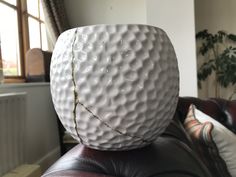8 Things that Causes Fiberglass Planters and Pots to Break
Even with their sturdy design, fiberglass planters can sometimes break or crack under certain conditions. If you’ve found your fiberglass pots looking a little worse for wear, understanding the common causes of these issues can help you take simple steps to avoid them. Here’s a closer look at what can make fiberglass planters vulnerable and how to keep them in great shape for longer.
1. Extreme Temperatures
Fiberglass holds up well under normal conditions, but it can weaken in extreme heat or cold. Hot temperatures can make the material softer and more flexible, which can lead to warping, while cold temperatures can make fiberglass brittle, which makes it prone to cracking.
How to Prevent It:
If you live in a climate that is very cold or hot, try moving planters indoors or into shaded areas to avoid direct exposure. Insulating the inside with a protective layer during the cold season can also help keep them from becoming too brittle.
2. Impact or Physical Pressure
Fiberglass is strong, but it’s still vulnerable to damage from hard impacts or pressure. Dropping, bumping, or pressing against these planters can lead to chips or cracks, especially in high-traffic areas or during handling.
How to Prevent It:
Keep your planters in low-traffic areas where they’re less likely to get bumped. Handle them carefully during transport, using both hands and lifting cautiously to avoid accidental drops.
3. Poor Drainage and Water Buildup
Because fiberglass is non-porous, water can collect inside if drainage isn’t set up properly. If water sits in the bottom and freezes, it can expand and stress the planter, leading to cracks. Similarly, water buildup can pressure the planter and cause structural damage over time.
How to Prevent It:
Check that your fiberglass planter has adequate drainage holes, and place rocks or gravel at the bottom before adding soil. This will help water drain properly and reduce pressure on the planter walls.
4. Lower-Quality Manufacturing
Not all fiberglass planters are made the same. Cheaper fiberglass products sometimes use less durable materials or skip certain steps in production, which can result in brittle planters that chip or break more easily.
How to Prevent It:
Buy well-made planters from reputable brands like ours. They generally withstand daily use and outdoor conditions much better than low-grade options.
5. Constant UV Exposure
Long-term exposure to direct sunlight can break down the resin in fiberglass, making it more likely to crack or even develop a powdery finish over time. This is especially common in planters left out in hot, sunny areas without any shade.
How to Prevent It:
If your planters are exposed to strong sunlight, consider applying a UV-resistant coating. Placing them in a spot with partial shade can also reduce UV exposure and extend their lifespan.
6. Excessive Soil or Plant Weight
Fiberglass planters are sturdy but aren’t meant to support very heavy loads. Too much soil or large plants with extensive root systems can put stress on the planter, causing it to bulge, warp, or even crack.
How to Prevent It:
Use lightweight soil mixes for larger planters and avoid planting large trees or plants with heavy root systems. Consider grouping smaller plants to achieve the full look you want without overloading the planter.
7. Chemicals from Cleaners or Fertilizers
Certain chemicals can damage the resin in fiberglass, making it more likely to crack or deteriorate. Fertilizers, pesticides, and cleaning agents can react with the material, leading to breakdowns over time.
How to Prevent It:
Use organic fertilisers and natural cleaning solutions on and around your planters to minimize chemical exposure. If you’re using strong chemicals nearby, protect your fiberglass planters by covering them temporarily.
8. Weak Structural Design
Sometimes, planters break simply because of poor design. Planters with thin walls or bases that don’t evenly distribute weight can be more susceptible to cracking or tipping over.
How to Prevent It:
Look for planters with thicker walls and a stable design. Thicker walls add strength, and even weight distribution helps keep the planter from stressing any single area.
Fiberglass planters are a good choice for many types of plants, but they need a bit of care to stay in top shape.
8 Things that Causes Fiberglass Planters and Pots to Break


